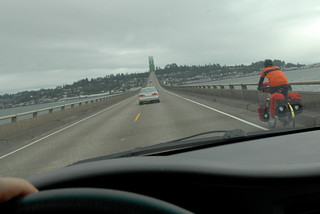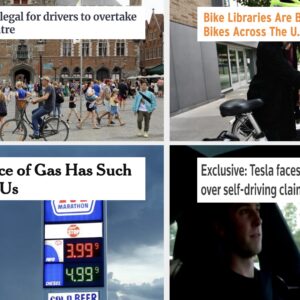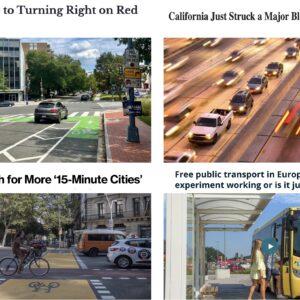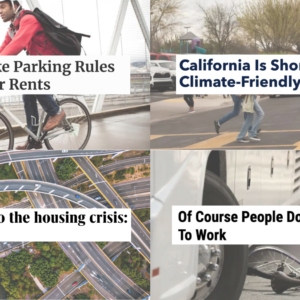This week’s Monday Roundup is brought to you Mountain Shop (NE 37th and Sandy), where you can learn about, buy, and rent excellent gear for your next bike adventure.
Three-foot rule: Chattanooga bike patrol officers are using custom ultrasound devices to measure cars’ passing distances.
Housing shortage: “None of us, not a single damn one of us, is entitled to live where we want to live for as long as we want to live at a price we can easily afford,” writes Tyler Hurst in Willamette Week. “It’s not fair at all. Nor is it fair to love a city and not want to share it.”
Housing myths: New housing doesn’t leads to higher rents, Willamette Week says, it’s the other way around.
Self-healing metal: The bike frames of the future may mend themselves.
Rolling joints: Customs officials in Arizona arrested a 17-year-old boy who stuffed his bike tires with three pounds of marijuana.
Death penalty: New York City’s right of way law assigns criminal misdemeanors for illegal driving, but only if someone actually dies.
Scofflaws: Nearly 1 in 10 people who drive in New York City run red lights.
Transit subsidies: Portland’s TriMet does fairly well on both ridership and efficiency in this national comparison.
Recruitment problem: “I don’t think we’re as far along as running is in making events that appeal to everyone,” says Fred Clements, executive director of the National Bicycle Dealers Association. Running is up 20 percent in the last five years, while the number of people biking hasn’t grown. (Portland-based “enthusiast of three-speed bicycles” Shawn Granton is among the experts quoted.)
Race race: Ayesha McGowan is out to become the country’s first African-American female bike-racing pro.
Seattle bike share: The city is applying for a $10 million federal TIGER grant that would quintuple its bike share system and add e-bikes.
Healthy biking: A new multinational study concluded that walking and biking investments return an average $13 worth of better community health outcomes for each $1 invested.
Advertisement
Beaverton downtown: It’s finally moving closer to getting one.
Solar bike path: The Amsterdam-area test installation is just as inefficient as engineers predicted it would be.
Bike theft: It’s a proven deterrant to bike use, which makes it “much more than petty larceny.” But police treat it about the same as a stolen TV.
St. Paul’s bike loop: The less bikey twin city is working on a plan that sounds sort of similar to Portland’s downtown Green Loop concept.
Bike Realtors: They can now be found from coast to coast.
“Cyclepreneurs”: A New York man has started a business advising people on starting bike-related businesses.
Decongestion charge: London’s fee on auto traffic entering its central business district seems to be working.
Dublin’s shift: Long richer in biking than in bike infrastructure, Ireland’s capital is preparing major limits on driving through its central city.
20% by 2020: That’s where Fort Collins (currently at 7 percent bike mode share) claims to be heading.
In the way of modern headlines, this one tells the story of your video of the week well: “These DIY Bike Signals Are Easy to Make and Last For Ages on One Battery.”








Thanks for reading.
BikePortland has served this community with independent community journalism since 2005. We rely on subscriptions from readers like you to survive. Your financial support is vital in keeping this valuable resource alive and well.
Please subscribe today to strengthen and expand our work.
Always an informative and interesting Monday roundup, thanks.
Looking forward to Portland getting a bike share program.
On Ft. Collins: It was named Money magazine’s Best Place to Live in the U.S. in 2006, No. 2 in 2008, and No. 6 in 2010
“In 2011, Allstate Insurance listed Fort Collins as “America’s Safest Driving City” in their annual “Best Drivers Report”. Drivers in Fort Collins average 14 years between collisions and are 26.8% less likely to be in a collision compared to the national average.”
20% people riding bikes, I’d be really curious how that would impact their growth rate… because screw living in Portland if they get that.
Looks like that story slug needs an edit: “Nearly [x] in 10 people …”
x = 10? Oh wait, that’s San Jose I’m thinking of…
Micheal – is there a missing # in your lead in?
“Scofflaws: Nearly # in 10 people who drive in New York City run red lights.”
Thanks, guys. Fixed. (It’s “nearly 1 in 10.”)
how about Staten Island? It is scary walking in many places there.
If people don’t like red light cameras, because they think they’re a money grab, then make offenders do community service at a local hospital. Have them spend 50 hours working with people who have been maimed and injured on our streets. 50 hours per infraction…
You should suggest that to Gina Pera, who’s absolutely incensed that there’s no citizen oversight because she had to pay $500 for doing 12 MPH through a stop sign (that sits directly between a transit center and international airport, BTW):
http://sanfrancisco.cbslocal.com/2015/02/09/number-of-red-light-camera-tickets-issued-at-millbrae-intersection-jumps-from-40-per-month-to-600/
http://www.wweek.com/portland/blog-33247-im_sorry_you_hate_my_apartment_i_think_its_nice.html
Anyone who believes that there is not a mother-load of anti-renter bigotry in PDX should read through some of the 1235 comments for the above piece. Its also pathetic that gentrification is used as an excuse for this hate. Apartment buildings on scuzzy non-residential arterials did not cause people to pay hundreds of thousands of dollars for bungalows in north and NE portland.
Is it anti-renter bigotry or is it more anti-working-remotely-from-a-bay-area-job-and-paying-$1300-for-a-1BR-doesn’t-seem-bad-at-all rage? Because I actually know a couple people that do that. A couple years ago I had a roommate from D.C. that worked from home and her income dwarfed me and my other housemates. Just a few short years ago on my very modest income I could rent a 1 bedroom by myself but now I couldn’t rent a studio alone if I wanted. Well, not if I wanted any money for any sort of entertainment after paying phone/student loans/bills/rent. That’s my problem with the massive influx of people.
Wake me up when we see the same kind of incendiary hate directed at a couple that purchased a bungalow for ~$300,000.
Moreover, we won’t see more affordable rent in this town without:
1. A cull of Portland renters.
2. Government regulation (e.g. inclusionary zoning/rent control).
or
3. An increase supply of rental housing.
I favor options 2 and 3 but judging from some of the 1235 comments at Willamette Week some Portlanders likely prefer option 1.
I won’t lie, I’d like to see a lot fewer people move here, and if a lot of people moved away, I wouldn’t feel bad at all. I’d be stoked.
I still don’t see the anti-renter thing you’re seeing, but anger that rents have gotten so completely out of hand.
“I won’t lie, I’d like to see a lot fewer people move here, and if a lot of people moved away, I wouldn’t feel bad at all. I’d be stoked.”
And I want a pony and vegan cheese that tastes exactly like manchego.
Yeah Soren. That would be cool too I guess.
Adopting option 2 can hinder the likelihood of option 3 making an impact because it puts downward pressure on prices.
So you admit you’re asleep on this issue.
It really seemed to me that much of the animus directed towards the author had to do that he was doing relatively well and was happy about it.
In NYC the right of way law is only used when there’s evidence that the pedestrian stepped off the curb while the walk signal was on. Once it starts flashing even with a countdown you aren’t allowed to enter. Consider how little time the walk signal is on excluding the flashing/countdown phase. At some intersections it’s fair to say 90% of pedestrians are expected to have to stop and wait before crossing.
crosswalk countdown timers are a waste of money… there’s no law dictating how fast you have to cross the street… their only valid use can be to let you know if you can still make it across if you hurry while entering while it’s counting down…
And that’s a waste because……?
Mayor Hales : Taxpayers demand you spend taxpayer money wisely.
Another independent study has proven that you can get at least “$13 worth of better community health outcomes for each $1 invested”. Let’s do this! Yesterday!
Compared to what else you can spend that $1 on? A B/C ratio of 13 is pretty good, but not exactly stellar.
Chattanooga has bike patrol officers *and* they have a 3ft passing law, which they enforce?! That sounds like something a platinum bike-friendly city would do after (if not before) an “urgent safety meeting”.
Oregon crosswalk signal right of way rules are similar. If the signal is flashing red or the equivalent, a person on foot should not enter the crosswalk.
It’s certainly frustrating. The heavily used crosswalks east and west-bound crossing Chavez on SE Hawthorne allow a 2.5 second opportunity to step off the curb.
How would motorists react to a 2.5 second green light followed by a 15 second yellow?
It just shows you which mode is boss.
I wonder if we could get Peter Koonce to respond to this?
To be fair, it doesn’t take cars 15 seconds to clear the intersection. It does take pedestrians that long. It’s just the nature of different modes moving at different speeds. Extending the walk time implies extending the overall cycle time, and there are probably ripple effects on light timing throughout the rest of the area from such a change.
crosswalk countdown timers are a waste of money… there’s no law dictating how fast you have to cross the street… their only valid use can be to let you know if you can still make it across if you hurry while entering while it’s counting down…
I actually like them a lot when I drive and ride bicycles. I use them to judge when it’s safe to enter the intersections. I often start slowing for a changing light before the yellow as a result of watching the countdown timers.
Even driving, the pedestrian signal count-downs tell the driver how long they have to wait, and people are more patient when they know how long it’s going to be, and that seems like a desirable outcome to me.
“In NYC the right of way law is only used when there’s evidence that the pedestrian stepped off the curb while the walk signal was on. Once it starts flashing even with a countdown you aren’t allowed to enter. Consider how little time the walk signal is on excluding the flashing/countdown phase. At some intersections it’s fair to say 90% of pedestrians are expected to have to stop and wait before crossing. …” lop
“Oregon crosswalk signal right of way rules are similar. If the signal is flashing red or the equivalent, a person on foot should not enter the crosswalk.” Babygorilla
Babygorilla…did you check Oregon law to see whether what you wrote is consistent with it? In one of his column’s the O’s Joe Rose also claimed that Oregon law doesn’t allow pedestrians to start out into the crosswalk after the countdown has begun. I have doubts as to whether this is true.
It doesn’t make much sense for it to be illegal for a pedestrian to making their way across the street during the crosswalk countdown phase. A logical reason for the countdown, is to provide to people walking across the street in crosswalks with these signals, an aid for them to estimate how much time is allotted and remaining in the countdown phase, as a means to help them decide whether they have enough seconds to safely make their way across the street.
As an example, the crosswalk countdown on Canyon at 117th in Beaverton, allots…I think it’s 22 seconds counting down after the ‘walk’ hand symbol appears for a couple seconds; wide street, 70′ or so. Normal walk can do it in 17 or 18.
These things are interesting; we’ve had a few conversations about them with our city planners and engineers. I’ve observed on several occasions that at popular intersections near my house, they start counting down almost immediately, and I’ve seen people simply standing there watching them while they have ample time to cross. Mostly it’s been older and/or Asian people that I’ve seen (small sample size). A few times I’ve said “it’s OK to go, you have plenty of time.” When I mentioned this to our staff, there were mixed responses on their understanding of the law here, and admittedly my own.
I’ve wondered if drivers tend to accelerate when they see the timers in a hurry to make sure they don’t get caught in the yellow (I think I probably do, subconsciously). Studies on this have tended to back this up, though this one show interesting results after breaking down the intersections and comparing trends:
http://www.ctvnews.ca/autos/countdown-crosswalk-signals-leading-to-more-crashes-study-1.1233782
Blind people, by the way, tend not to heed the countdown timers…
Not many intersections have audio crossing guidance, but the ones I’ve seen that do, stop playing the walk sound as soon as the hand changes from white to count-down.
Especially since the don’t walk phase is timed to be long enough for a slow walker. So an average speed walker could enter a couple seconds after it starts flashing and still be able to walk to the curb on the other side before it finishes.
correct.
no dawdling, grandma!
But that person could face a citation. The timer or flashing is designed to facilitate right of way movement for people on foot and people with vehicles.
You’re right, it really doesn’t make much sense, but my (and others’) reading of ORS 814.010 indicates that it is illegal to start crossing when the hand is displayed, which it is when the timer is counting down.
Mark…It’s good you’ve given some thought to what are the rights and responsibilities of people using crosswalks with the countdown crosswalk signals.
Obviously, it’s not illegal for a someone to be proceeding across the street as a pedestrian in the crosswalk during the countdown phase of the crosswalk signal. I would say also, that it’s most likely not illegal for someone to start crossing the street in the crosswalk after the crosswalk countdown has commenced. From ORS 814.019 which you referred to, check out what (4) of this law specifies:
“…(4) A pedestrian facing a traffic control device with a steady red light shall not enter the roadway unless otherwise directed by a pedestrian control signal. …” http://www.oregonlaws.org/ors/814.010
Yes, on crosswalk countdown type signals, the red hand does display during the countdown, but: It flashes. What a flashing red light means in terms of traffic regulation, is that the road user may resume travel after stopping at the flashing red light to check that the way is clear before proceeding cautiously. The flashing red hand means the same thing as used with crosswalk countdown type signals.
The caveat with these countdown lights, is the burden of responsibility upon people crossing, to use good judgment in estimating whether they can safely cross the street with whatever remaining time is displayed on the countdown. Cut yourself short and get caught out in the intersection with the steady red hand displayed, and you’re due a citation.
Tonight, same intersection out in the Beav, I saw a guy start out across the 23 second countdown intersection, with just 5 seconds remaining. He was in a hurry, ran to the intersection, kind of stopped before crossing, and jogged across, a couple seconds shy. Nice try, but kind of dangerous if there happened to a be a car across the intersection looking for a right turn on red opportunity. I figure a cop could have cited him for not allowing himself enough of the countdown time to completely cross before the steady red hand.
Regarding the red light cameras, I think the ones by Bridgeport Village have been deactivated. In the past 9 months, I haven’t seen them flash at anyone running the red lights there, even with such blatant violations as entering the intersection to turn left from 72nd onto Bridgeport as the light turns red, then sitting in line in the middle of the intersection and blocking other traffic, which has a green, from going.
The complaint that they are only to generate revenue is stupid– if you don’t want a ticket, stop at the red light. How hard is it? Same with speed cameras– don’t speed, you won’t get a ticket.
Drivers forget that they have a choice– to go the speed limit, stop (as in, full cessation of movement) at red lights and stop signs, obey the traffic laws, etc. If you choose not to, you need to abide by the consequences.
I think a lot of the objections are to intersections where the yellow timings have been diminished from the engineering-recommended values to shorter times (presumably in an attempt to catch more people). And the intersections where a legal stop-and-right-turn triggers the detector and a citation that the user then has to go to court to fight. Or intersections where a blinking-yellow makes it legal to enter the intersection but then the camera triggers on the car leaving the intersection at the end of the cycle.
Of course as you say, some of it is just annoyance and being unable to get away with an illegal move, but I think that’s the minority of complaints.
Interesting, negative scenarios. I wonder what frequency their occurrence is with red light camera citations issued. If common and excessive, maybe some adjustment to the camera equipments’ function is needed.
Just thinking how much time the yellow light should be set for; logically, enough seconds and split seconds to allow crossing the distance across the intersection, plus an additional car length or so, at the legal mph speed. When yellow lights display, too many people proceed straight on through, even though it began displaying when they were more than sufficiently far back from the intersection to allow a safe stop. We are going to have safer roads if we can cut back on this happening.
Yellow lights are almost all either 3 or 4s. I hesitate to even mention it without the link, and it wasn’t Oregon, but the average yellow light time at red-light-enforced intersections is closer to 2.something sec.
Stop compliance is also fairly well-studied. People will generally stop for the light if they can do so without decelerating more than 8mph/sec. Above that threshold, they go through. It would certainly be technically possible for the light to evaluate oncoming traffic and have adaptive yellow timings intended to achieve full compliance (then maybe even holding the red until the intersection is actually clear). But traffic control technology seems to creep forward at a snail’s pace.
I’m skeptical of the claim that cities deliberately short time their traffic signals yellow light phase to ‘issue more citations’, or for whatever other reason, because I think it’s a dangerous practice. To see how many seconds they’ve been allotted, I could fairly easily clock the seconds for some of the yellow light cycles at the Canyon Rd and 117th intersection.
Just last week while waiting at the crosswalk signal for the ‘walk’ signal, the left turn lane across the intersection (it gets the green light immediately before the crosswalk light goes to ‘walk’.), two or three of the line of cars waiting in the left turn lane proceeded into the intersection most likely after the light had been yellow; obvious, because my crosswalk light signaled ‘walk’ before they had crossed over the crosswalk.
I think they could have easily and safely stopped at the yellow light, but instead they ran a red light, and cut into the crosswalk countdown seconds allotted to people on foot to cross this very wide, very busy and dangerous intersection. All of the two or three people driving should have received citations. This intersection though, does not have red light cameras, unlike its companion intersection to the south on Beaverton-Hillsdale Hwy and Griffith Parkway.
http://archive.wtsp.com/news/local/story.aspx?storyid=316418 is one example of shorting the yellow that I could find quickly. It’s even more egregious when paired with studies like http://saferstreetsla.org/wp-content/uploads/reports/A%20Compendium%20of%20Yellow%20Interval%20Increase%20Studies.pdf that show longer yellow timings reduce violations and crashes.